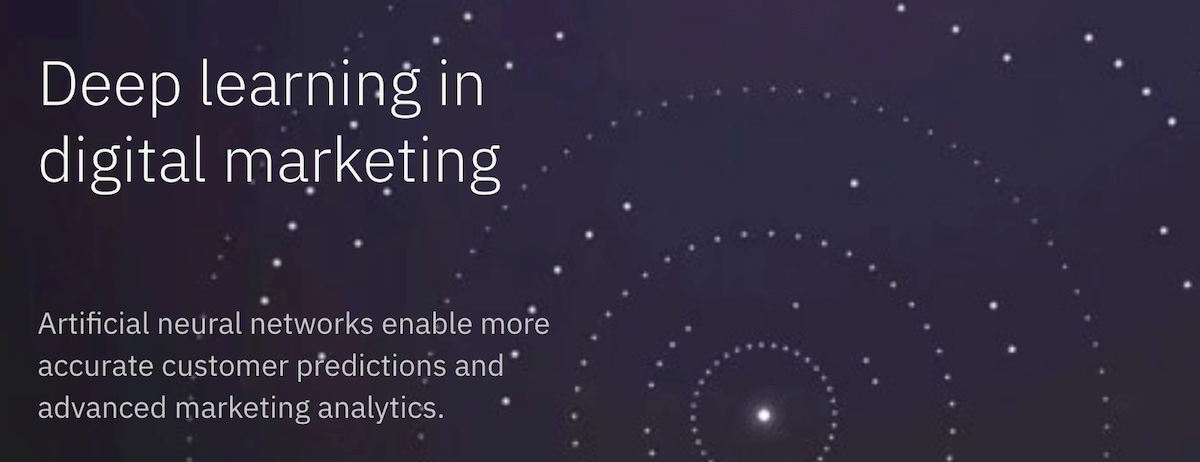
The digital marketing industry is moving towards deep learning in order to create more intelligent, better predictive systems. These systems can determine the probability of customers’ decisions based on their activities and internet habits, even when there was no previous data about them.
An example would be Google’s advertising system which will show you relevant ads based on your search history because it has learned what you’re interested in via your previous searches and posts on social media networks like Instagram or LinkedIn.
In this introduction to deep learning in digital marketing we’ll cover the following topics:
- What is deep learning?
- How deep learning works
- The advantages of deep learning for marketers
- Deep learning applications in digital marketing
- How to get started with marketing deep learning
- AI Tools You can use Today

What is deep learning?
Deep learning is a branch of machine learning in which neural networks are used to teach machines how to think in the same way humans do. These artificial neural networks are very complicated algorithms, with millions of parameters allowing them to learn with each new piece of data they’re exposed to. In addition, these “neurons” can change their connections based on what they’ve learned, further strengthening their ability to predict future behavior.
In the context of digital marketing, research in deep learning led to intelligent systems that predict customer activity and decisions. These predictions are carried out by artificial neural networks (ANNs). ANNs are a form of machine learning algorithm that tries to mimic the architecture of the human brain’s neurons and synapses.
Deep learning explores the idea that neurons can be thought of as processing elements (e.g., multipliers or adders) instead of simple mathematical functions. For example, deep learning has created more advanced neural networks than previously used in traditional machine learning algorithms. These networks contain many more processing elements than just simple mathematical functions.
Warren McCulloch and Walter Pitts first presented the concept of ANNs and deep learning in 1943. In their step-by-step book “Biological Cybernetics” the researchers explored how to put the ideas into practice. Artificial neural networks get widely used in AI systems at various classification levels, including customer sentiment analysis, speech recognition, and computer vision.
In marketing, deep learning is used to build intelligent systems that predict consumers’ buying behavior based on their digital activities.In practical terms, deep learning has been used to create machines that recognize images, videos, and audio content and understand human language.
Examples of deep learning powered systems in digital marketing are:
- Google Ads (Google uses a combination of deep learning and artificial intelligence to make better predictions of customer behaviors).
- Amazon’s Alexa assistant (Amazon uses deep learning to improve the service it gives to its customers by offering new products and services, making recommendations and carrying out transactions).
- IBM Watson (IBM uses deep learning to solve complex customer problems and support its customers in making better business decisions).
How deep learning works
Deep learning techniques are used to connect the input with the output in an artificial neural network.
ANNs are interconnected groups of nodes (artificial neurons) that connect to each other. These groups of neurons are trained using data that has already been classified so that the system can organize new data.
The more data you feed into the network, the more it learns and gets better at processing new data correctly. Each neuron connects to one or more neurons by creating links between them. The links have a weighting attached that produces a reaction from each neuron when a signal passes through it. In digital marketing, you can use this reaction to predict customer behavior based on previous interactions with your website, email campaigns, and digital ads.

source: ibm.com
The most basic way to think of deep learning is like this: machines, like humans, can exhibit a large variety of behaviors. They can look at new objects and decide whether or not they’re harmful. They can learn to read new words and understand their meanings. They can even teach themselves to beat highly-skilled Go masters! However, unlike humans, machines rely on numeric values in order to perform these tasks.
When they’re exposed to new words, for example, they must be told what each word means by their creators. For humans, this process is much more intuitive. Once we see a new object or learn a new word, we can recognize it and understand its meaning without having to memorize statistics about its appearance or definition.
The advantages of deep learning for marketers
Why is deep learning so important in digital marketing? The simple answer is that it allows machines to recognize subtle patterns in order to better advertise products or services to target audiences.These are several advantages of deep learning to use by marketers, as follows below.
Predict buyer behavior
Amazon’s intelligent assistant Alexa is the brainchild of deep learning. Amazon’s deep learning algorithm can detect when a customer is bored or looking for something else to do. This enables Amazon to make suggestions to the user based on their recent shopping history. As well as making suggestions, it can also understand what you are looking for and send relevant advertisements (Facebook’s News Feed was famously changed following feedback that its algorithms were not always producing relevant ads).
Analyze customer sentiment
The AI technology behind social networks like LinkedIn and Facebook allows it to understand the moods of its users in real-time. This allows Facebook to change the content of its News Feed (blog posts, videos etc.) in order to adjust itself to the actual moods of each user. This is a great example of identifying the moods and reactions of people using deep learning. This is a feature that was implemented after a lot of customer feedback, and it would not have been possible without marketing deep learning.
Recognize Speech recognition
Deep learning has been used to create an AI system that can listen and understand spoken language. This deep learning system is able to learn from data sets containing millions of sentences, including translation from one language into another, speech translation and even conference interpretation. This is an example of how deep learning has enabled the creation of chatbots and virtual assistants that can respond to customer’s spoken questions in human-like ways.
Deep learning applications in marketing
Deep learning as a field is beginning to see breakthroughs as a result of advances in computer vision and natural language processing. In the image recognition space, for example, deep learning can be used to recognize objects that humans may be unable to. One example of this is using the network designed by Google Deep Mind to search for cancer from scans of patients’ lungs. Deep learning networks are also capable of making difficult decisions based on large data sets; one example would be knowing when it’s time for more advertising on Instagram or Google.
Let’s take a look at how deep learning can be used by marketers as well as some potential implications for digital marketing as a whole.As marketing continues its transition into the digital age, deep learning will likely be frequently used by modern marketers. At the very least, deep learning may be used to train companies’ existing marketing software to make smarter decisions; however, this could progress even further by allowing digital marketers to create their own decision-making algorithms without any human intervention.
Besides, marketers’ ability to make effective use of AI will likely be heavily influenced by the personal characteristics of the individual. For instance, having an affinity for cartoons may make it easier to predict which pictures would work for social media ads; this is because deep learning networks are capable of recognizing certain patterns.
Deep learning makes automation possible. Large volumes of data are needed to train a neural network, which is one of the main reasons why it is not used in most businesses. AI technologies, such as deep learning, can be used to automate multiple processes using a single algorithm with different outputs. This can be beneficial for many organizations that have a significant amount of data but lack the computational power to process or analyze that data alone.
Implications for digital marketing
The implications of the widespread use of deep learning in digital marketing are unclear at this point. On the one hand, it may lead to marketers making more informed decisions. On the other hand, marketing automation software entirely replacing human marketers is a real threat. Either way, deep learning will be an essential part of how marketing organizations operate in the future.
How to get started with marketing deep learning
Go over these five steps for getting started with deep learning in your marketing department:
1. Understand customer needs more effectively than traditional methods
Regarding customer insight, most traditional methods can only go so far. Surveys, focus groups, and even face-to-face customer interactions are too human-centered and only give a narrow view of their real issues.
By contrast, deep learning addresses the most fundamental customer problems by offering an unbiased look at the most significant issues for each customer or user segment based on their social media or search history. This approach can quickly identify and address problems with personalized messaging that is more effective than traditional methods.
2. Deliver real-time, personalized content
Even the best marketers have trouble predicting what content their customers want to see in real-time. Whether it is an ad on Google or LinkedIn, most marketers cannot reach the right people with the right message at the right time due to limited data.
With deep learning, marketers can identify what kind of content users are interested in, when they are most likely to see it, and even who else they will be interested in seeing it if they aren’t already exposed to that content themselves. By doing this, marketers can use highly personalized messaging to build strong relationships with customers and ensure that their online advertising is highly targeted.
3. Address customer problems more effectively than traditional methods
Customer loyalty isn’t built through the latest campaign or the best offer in a catalog, it is built when a company can meet a customer’s most pressing needs like never before.
For example, if you are running ads for dishwashers on Facebook or Google, you may have had an ad showing up for people searching for dishwashers but not actually using one.
With deep learning, marketers can use their customer’s own preferences to send them directions to the nearest location. In this way, it becomes much easier for companies to respond quickly and effectively when a customer needs attention.4. Analyze social media posts
Possibly more than any other technology right now, social media channels have become a window into the beliefs and issues of people around the world. People use social media channels to express their views about politics, economics, and more, allowing us to understand better what people are thinking at any given time.
However, this information gets often buried under the noise of posts, hashtags, and comments. With deep learning marketing, however, companies can mine these posts to better understand sentiment and trends of belief through consumer online behavior.
5. Track text-based searches on the web
The ability to extract meaning from text is one of our most powerful communication tools. And yet many marketers are only using text-based search to narrow down their audiences while wasting valuable data in the process.
- With more profound insight into what consumers are searching for, marketers can reach out to people more effectively on their own terms while boosting brand communication on social media channels at the same time.
AI deep learning marketing tools you can use today
SEO and Content:
- MarketMuse: Uses AI to analyze content and compare it against the existing content on your site to suggest improvements and topics that will increase your authority and relevance in your industry.
- Clearscope: Helps optimize content for SEO by providing insights based on the analysis of current high-ranking web pages.
- SurferSEO: Analyzes your content against top-performing pages to provide keyword suggestions, content structure, and optimization advice.
- SEMRush: Offers comprehensive SEO tools, including site audits, keyword research, and competitor analysis, leveraging AI for market insights.
Lead Generation, ABM (Account-Based Marketing), and Outreach:
- Leadfeeder: Uses AI to identify anonymous website visitors and turn them into quality leads by integrating CRM and email marketing tools.
- 6Sense: It offers ABM and predictive analytics capabilities to target potential accounts effectively.
- Outreach: Utilizes machine learning to optimize customer engagement through personalized communication strategies.
- Engagio (now part of Demandbase): Specializes in ABM strategies, providing deep insights and engagement metrics to tailor outreach efforts.
Demand Generation and Brand Awareness:
- HubSpot: While not exclusively using deep learning, HubSpot’s comprehensive marketing platform uses advanced analytics and machine learning for better targeting and engagement strategies.
- Pardot by Salesforce: Employs AI features to enhance lead scoring and nurturing, improving demand generation efforts.
- AdRoll: Uses AI to personalize web, social, and email ad campaigns to boost brand awareness and demand generation.
- Act-On: A marketing automation platform that leverages AI to optimize engagement strategies for demand generation.
Employer Branding:
- Glassdoor: Offers insights into employer branding and reputation management. Although not a deep learning tool per se, it leverages extensive data analytics to help companies understand and improve their employer brand.
- LinkedIn Talent Solutions: Utilizes AI to help enhance your employer brand by targeting and engaging with suitable candidates.
- BambooHR: Focuses on internal branding and employee satisfaction, indirectly affecting employer branding through enhanced work culture.
- Phenom People: A Talent Experience Management platform that uses AI to improve candidate experiences and employer branding.
Customer Research:
- Talkwalker: A robust social listening and analytics platform that uses AI to analyze social media, blogs, and other online sources to provide insights into consumer sentiment, brand perception, and market trends.
- Sprout Social: Offers deep learning-powered social listening tools to analyze and understand customer conversations and trends on social media, aiding in comprehensive market and consumer research.
- Brand24: Provides real-time social media monitoring and analytics to gauge customer sentiment and brand reputation.
- Meltwater: Offers media monitoring and social listening tools to track brand mentions and analyze customer sentiment across the globe.
Conclusion
Deep learning in the marketing sector is relatively new but offers enormous growth potential for companies willing to break away from traditional CRM and business development methods.
Whether using deep learning tools to look at customer problems, deliver real-time content or text-based search, deep learning can help marketers communicate with customers more effectively than ever before. And with more companies adopting AI technologies for their marketing needs, more profound insights will be made possible across the industry in the years ahead.







